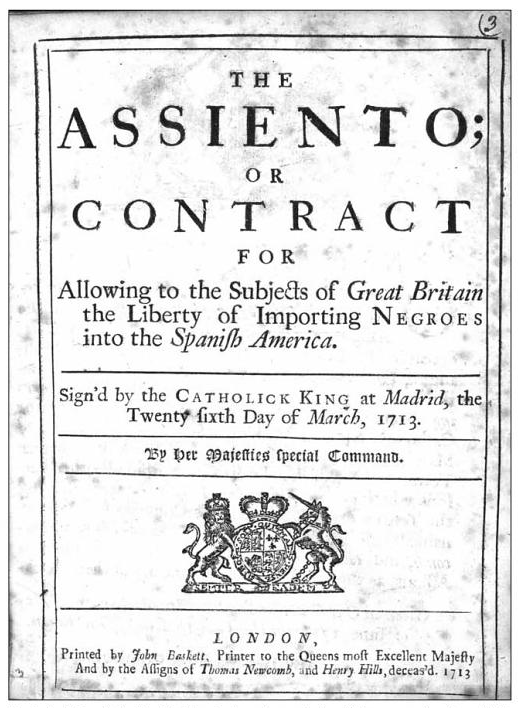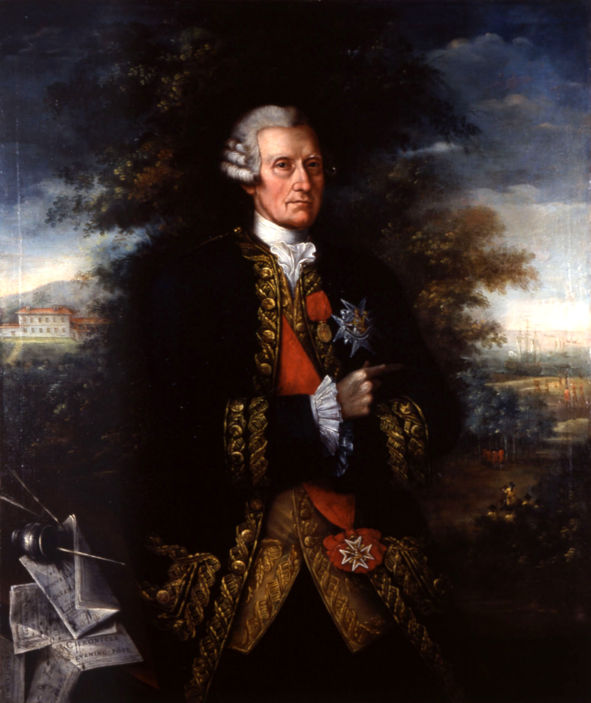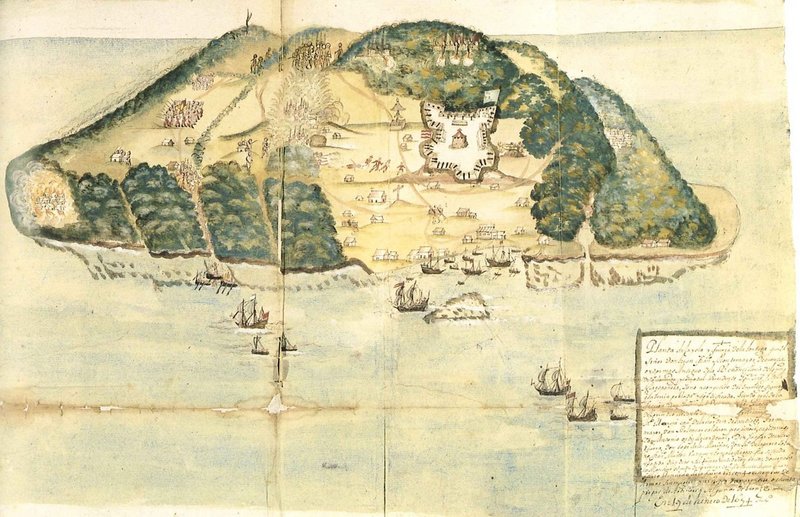|
Treaty Of Madrid (5 October 1750)
The Treaty of Madrid, also known as the Treaty of Aquisgran, was a commercial treaty between Britain and Spain, formally signed on 5 October 1750 in Madrid. Commercial tensions over the ''Asiento'', a monopoly contract allowing foreign merchants to supply slaves to Spanish America (which was granted by the Spanish Crown to Britain via the 1713 Treaty of Utrecht), and alleged smuggling of British goods into Spain's American colonies led to the War of Jenkins Ear in 1739. This was followed by the War of the Austrian Succession, ended by the 1748 Treaty of Aix-la-Chapelle. In addition to the ''Asiento'', there was also a substantial import and export trade between Spain and Britain, carried out by British merchants based in Cádiz. Due to an error by negotiators at Aix-la-Chapelle, the treaty failed to renew their trading privileges, which were treated as cancelled by the Spanish. Both sides also claimed they were owed large sums of money in regards to the ''Asiento''. However, t ... [...More Info...] [...Related Items...] OR: [Wikipedia] [Google] [Baidu] |
Treaty Of Aix-la-Chapelle (1748)
The 1748 Treaty of Aix-la-Chapelle, sometimes called the Treaty of Aachen, ended the War of the Austrian Succession, following a congress assembled on 24 April 1748 at the Free Imperial City of Aachen. The two main antagonists in the war, Britain and France, opened peace talks in the Dutch city of Breda in 1746. Agreement was delayed by British hopes of improving their position; when this failed to occur, a draft treaty was agreed on 30 April 1748. A final version was signed on 18 October 1748 by Britain, France, and the Dutch Republic. The terms were then presented to the other belligerents, who could either accept them or continue the war on their own. Austria, Spain, and Sardinia had little choice but to comply, and signed separately. Modena and Genoa joined together on 21 January 1749. The treaty largely failed to resolve the issues that caused the war, while most of the signatories were unhappy with the terms. Maria Theresa resented Austria's exclusion from the talks, ... [...More Info...] [...Related Items...] OR: [Wikipedia] [Google] [Baidu] |
José De Carvajal Y Lancáster
José de Carvajal y Lancáster (1698–1754) was a Spanish statesman. Biography He was son of the Duke of Liñares and his mother was descendant of infante Jorge de Lancastre, a natural son of King John II of Portugal. After graduating at the University of Salamanca, he was appointed ''oidor'' (judge) of the ''Chancillería'' of Valladolid and later councillor of the Council of the Indies. Prime minister José del Campillo elected him as his personal secretary. In 1746, he was appointed president of the Junta of Commerce and Money, and promoted the establishment of chartered corporations for the improvement of regional trade and manufacture. The new king Ferdinand VI appointed him First Secretary of State that same year, and carried out a neutrality policy. In 1750, he signed the agreement between Spain and Portugal that finished the disputes over the borders of Río de la Plata and Brazil; Colonia del Sacramento returned to Spain in exchange of some Paraguayan territories. ... [...More Info...] [...Related Items...] OR: [Wikipedia] [Google] [Baidu] |
South Sea Company
The South Sea Company (officially The Governor and Company of the merchants of Great Britain, trading to the South Seas and other parts of America, and for the encouragement of the Fishery) was a British joint-stock company founded in January 1711, created as a public-private partnership to consolidate and reduce the cost of the national debt. To generate income, in 1713 the company was granted a monopoly (the Asiento de Negros) to supply African slaves to the islands in the "South Seas" and South America. When the company was created, Britain was involved in the War of the Spanish Succession and Spain and Portugal controlled most of South America. There was thus no realistic prospect that trade would take place, and as it turned out, the Company never realised any significant profit from its monopoly. However, Company stock rose greatly in value as it expanded its operations dealing in government debt, and peaked in 1720 before suddenly collapsing to little above its ... [...More Info...] [...Related Items...] OR: [Wikipedia] [Google] [Baidu] |
Ricardo Wall
Richard Wall y Devereux (5 November 1694 – 26 December 1777) was a Spanish- Irish cavalry officer, diplomat and minister who rose in Spanish royal service to become Chief Minister. He is usually referred to as Ricardo Wall. Early life Wall belonged to a family settled in Kilmallock, one of whom was Bishop of Limerick. Richard "Ricardo" Wall y Devereux was born at Nantes to a family of Irish Jacobite refugees, supporters of the Catholic James II, deposed King of England, Scotland and Ireland. He was baptized two days after his birth at the Cathedral Church of Saint Nicholas in unfavourable circumstances: his father, Matthew "Matías" Wall of Killmallock, Co. Limerick, a long-serving officer in King James II's cavalry, was absent. His family then lived in the "pit of the well of the silver" supported by a relative, probably Gilbert Wall, the clockmaker. Nothing much is known about his early years. Around 1710, he was introduced as page to the Bavarian Princess Marie Anne ... [...More Info...] [...Related Items...] OR: [Wikipedia] [Google] [Baidu] |
Anglophile
An Anglophile is a person who admires or loves England, its people, its culture, its language, and/or its various accents. Etymology The word is derived from the Latin word ''Anglii'' and Ancient Greek word φίλος ''philos'', meaning "friend". Its antonym is Anglophobe. History Overview An early use of ''Anglophile'' was in 1864 by Charles Dickens in '' All the Year Round'', when he described the ''Revue des deux Mondes'' as "an advanced and somewhat 'Anglophile' publication." In some cases, the term ''Anglophilia'' represents an individual's appreciation of English history and traditional English culture (e.g. William Shakespeare, Jane Austen, Samuel Johnson, Gilbert and Sullivan). Anglophilia may also be characterized by fondness for the British monarchy and system of government (e.g. the Westminster system of parliament), and other institutions (e.g. Royal Mail), as well as nostalgia for the former British Empire and the English class system. Anglophiles may enjoy Eng ... [...More Info...] [...Related Items...] OR: [Wikipedia] [Google] [Baidu] |
Thomas Pelham-Holles, 1st Duke Of Newcastle
Thomas Pelham-Holles, 1st Duke of Newcastle upon Tyne and 1st Duke of Newcastle-under-Lyne, (21 July 169317 November 1768) was a British Whig statesman who served as the 4th and 6th Prime Minister of Great Britain, his official life extended throughout the Whig supremacy of the 18th century. He is commonly known as the Duke of Newcastle. A protégé of Sir Robert Walpole, he served under him for more than 20 years until 1742. He held power with his brother, Prime Minister Henry Pelham, until 1754. He had then served as a Secretary of State continuously for 30 years and dominated British foreign policy. After Henry's death, the Duke of Newcastle was prime minister six years in two separate periods. While his first premiership was not particularly notable, Newcastle precipitated the Seven Years' War, and his weak diplomacy cost him the premiership. After his second term, he served briefly in Lord Rockingham's ministry, before he retired from government. He was most effective ... [...More Info...] [...Related Items...] OR: [Wikipedia] [Google] [Baidu] |
Tortuga (Haiti)
Tortuga Island (french: Île de la Tortue, ; ht, Latòti; es, Isla Tortuga, , ''Turtle Island'') is a Caribbean island that forms part of Haiti, off the northwest coast of Hispaniola. It constitutes the ''commune'' of Île de la Tortue in the Port-de-Paix arrondissement of the Nord-Ouest department of Haiti. Tortuga is in size and had a population of 25,936 at the 2003 Census. In the 17th century, Tortuga was a major center and haven of Caribbean piracy. Its tourist industry and references in many works have made it one of the most recognized regions of Haiti. History The first Europeans to land on Tortuga were the Spanish in 1492 during the first voyage of Christopher Columbus into the New World. On December 6, 1492, three Spanish ships entered the Windward Passage that separates Cuba and Haiti. At sunrise, Columbus noticed an island whose contours emerged from the morning mist. Because the shape reminded him of a turtle's shell, he chose the name of Tortuga. Tortuga wa ... [...More Info...] [...Related Items...] OR: [Wikipedia] [Google] [Baidu] |
Charles II Of England
Charles II (29 May 1630 – 6 February 1685) was King of Scotland from 1649 until 1651, and King of England, Scotland and Ireland from the 1660 Restoration of the monarchy until his death in 1685. Charles II was the eldest surviving child of Charles I of England, Scotland and Ireland and Henrietta Maria of France. After Charles I's execution at Whitehall on 30 January 1649, at the climax of the English Civil War, the Parliament of Scotland proclaimed Charles II king on 5 February 1649. But England entered the period known as the English Interregnum or the English Commonwealth, and the country was a de facto republic led by Oliver Cromwell. Cromwell defeated Charles II at the Battle of Worcester on 3 September 1651, and Charles fled to mainland Europe. Cromwell became virtual dictator of England, Scotland and Ireland. Charles spent the next nine years in exile in France, the Dutch Republic and the Spanish Netherlands. The political crisis that followed Cromwell's death in 1 ... [...More Info...] [...Related Items...] OR: [Wikipedia] [Google] [Baidu] |
British Ambassador To Spain
The Ambassador of the United Kingdom to Spain is the United Kingdom's foremost diplomatic representative in the Kingdom of Spain, and in charge of the UK's diplomatic mission in Spain. The official title is His Britannic Majesty's Ambassador to the Kingdom of Spain. The British ambassador to Spain is also non-resident ambassador to the Principality of Andorra. In 1822, Foreign Secretary George Canning downgraded the Embassy to a Mission, and the Head of Mission from an Ambassador to an Envoy Extraordinary and Minister Plenipotentiary, to reflect Spain's decreased importance on the world stage. The Mission in Madrid was upgraded to a full Embassy once more on 9 December 1887.Chris Cook and Brendan Keith, ''British Historical Facts 1830-1900'', Macmillan 1975, page 168 List of heads of mission The following is a partial list of British ambassadors to Spain. Titles of the heads of mission: * From 1509 to 1683: Ambassador * From 1683 to 1710: Envoy Extraordinary * From 17 ... [...More Info...] [...Related Items...] OR: [Wikipedia] [Google] [Baidu] |
Philip V Of Spain
Philip V ( es, Felipe; 19 December 1683 – 9 July 1746) was King of Spain from 1 November 1700 to 14 January 1724, and again from 6 September 1724 to his death in 1746. His total reign of 45 years is the longest in the history of the Spanish monarchy. Philip instigated many important reforms in Spain, most especially the centralization of power of the monarchy and the suppression of regional privileges, via the Nueva Planta decrees, and restructuring of the administration of the Spanish Empire on the Iberian peninsula and its overseas regions. Philip was born into the French royal family (as Philippe, Duke of Anjou) during the reign of his grandfather, King Louis XIV. He was the second son of Louis, Grand Dauphin, and was third in line to the French throne after his father and his elder brother, Louis, Duke of Burgundy. Philip was not expected to become a monarch, but his great-uncle Charles II of Spain was childless. Philip's father had a strong claim to the Spanish throne, bu ... [...More Info...] [...Related Items...] OR: [Wikipedia] [Google] [Baidu] |
John Montagu, 4th Earl Of Sandwich
John Montagu, 4th Earl of Sandwich, PC, FRS (13 November 1718 – 30 April 1792) was a British statesman who succeeded his grandfather Edward Montagu, 3rd Earl of Sandwich as the Earl of Sandwich in 1729, at the age of ten. During his life, he held various military and political offices, including Postmaster General, First Lord of the Admiralty, and Secretary of State for the Northern Department. He is also known for the claim that he was the eponymous inventor of the sandwich. Biography Early years John Montagu was born in 1718, the son of Edward Montagu, Viscount Hinchingbrooke. His father died when John was four, leaving him as his heir. His mother soon remarried and he had little further contact with her. He succeeded his grandfather as Earl of Sandwich in 1729, at the age of ten. He was educated at Eton and at Trinity College, Cambridge, and spent some time travelling, initially going on the Grand Tour around Continental Europe before visiting the more unusual dest ... [...More Info...] [...Related Items...] OR: [Wikipedia] [Google] [Baidu] |








